Effect of Chloride Salt Erosion on the Properties of Straw Fiber Reactive Powder Concrete
Abstract
1. Introduction
2. Experimental
2.1. Materials and Sample Preparation
2.1.1. Materials
2.1.2. Sample Preparation
2.2. Chloride Salt Environments
2.3. Measurement Method
2.3.1. Slump Flow and Setting Time Experiments
2.3.2. Mechanical Property Experiments
2.3.3. Compactness Experiments
2.3.4. Electrical Performance Test
3. Results and Discussions
3.1. Slump Flow and Setting Time Analysis
3.2. Mass Loss Analysis
3.3. Ultrasonic Velocity Loss Analysis
3.4. Mechanical Strength Analysis
3.5. Flexural Toughness Analysis
3.6. Electrochemical Performance Analysis
4. Conclusions
Author Contributions
Funding
Institutional Review Board Statement
Informed Consent Statement
Data Availability Statement
Conflicts of Interest
References
- Yusuke, K.; Masaki, M.; Ryuji, N. Verification test of restoration effect of offshore concrete structure using permanent formwork panels and underwater inseparable mortar. Int. J. Civ. Eng. 2021, 19, 1111–1124. [Google Scholar]
- Li, B.; Chen, Z.; Wang, S.; Xu, L. A Review on the Damage Behavior and Constitutive Model of Fiber Reinforced Concrete at Ambient Temperature. Constr. Build. Mater. 2024, 412, 134919. [Google Scholar]
- Wang, Y.; Qiao, P.; Sun, J.; Chen, A. Influence of Fibers on Tensile Behavior of Ultra-High Performance Concrete: A Review. Constr. Build. Mater. 2024, 430, 136432. [Google Scholar]
- Cao, Z.; Wang, K.; Peng, X.; Wang, H.; Huang, R. Influence of NaCl Solution External Erosion on Corrosion Resistance of RPC Reinforced with Straw Fiber. Coatings 2023, 13, 1308. [Google Scholar] [CrossRef]
- Grzymski, F.; Musiał, M.; Trapko, T. Mechanical Properties of Fibre Reinforced Concrete with Recycled Fibres. Constr. Build. Mater. 2019, 198, 323–331. [Google Scholar]
- Esaker, M.; Thermou, G.E.; Neves, L. Impact Resistance of Concrete and Fibre-Reinforced Concrete: A Review. Int. J. Impact Eng. 2023, 180, 104722. [Google Scholar]
- Allam, H.; Duplan, F.; Amziane, S.; Burtschell, Y. Assessment of Manufacturing Process Efficiency in the Dispersion of Carbon Fibers in Smart Concrete by Measuring AC Impedance. Cem. Concr. Compos. 2022, 127, 104394. [Google Scholar]
- Cao, X.; Quan, Y.; Ren, Y.; Fu, F.; Jin, Q.; He, D.; Zheng, Y. Experiment study on reactive powder concrete beams using spirals reinforcement under torsion. Eng. Struct. 2023, 290, 116361. [Google Scholar]
- Ge, W.; Zhang, Z.; Ashour, A.; Li, W.; Jiang, H.; Hu, Y.; Shuai, H.; Sun, C.; Li, S.; Liu, Y. Hydration characteristics, hydration products and microstructure of reactive powder concrete. J. Build. Eng. 2023, 69, 106306. [Google Scholar]
- Liang, Z.; Peng, X.; Wang, H. The Influence of Aspect Ratio of Steel Fibers on the Conductive and Mechanical Properties of Compound Cement Reactive Powder Concrete. Coatings 2023, 13, 331. [Google Scholar] [CrossRef]
- Alharbi, Y.R.; Abadel, A.A.; Salah, A.A.; Mayhoub, O.A.; Kohail, M. Engineering properties of alkali-activated materials reactive powder concrete. Constr. Build. Mater. 2021, 271, 121550. [Google Scholar]
- Hou, X.; Wang, N.; He, T.; Chen, C. Compressive Stress-Strain Relationship of Steam Free Reactive Powder Concrete at Ultra-Low Temperatures. Cem. Concr. Compos. 2024, 152, 105655. [Google Scholar]
- Mayhoub, O.A.; Nasr, E.S.A.; Ali, Y.A.; Kohail, M. The influence of ingredients on the properties of reactive powder concrete: A review. Ain Shams Eng. J. 2021, 12, 145–158. [Google Scholar]
- Richard, P.; Cheyrezy, M. Composition of reactive powder concretes. Cem. Concr. Res. 1995, 25, 1501–1511. [Google Scholar]
- Shafieifar, M.; Farzad, M.; Azizinamini, A. New connection detail to connect precast column to cap beam using ultra-high-performance concrete in accelerated bridge construction applications. Transp. Res. Rec. 2018, 2672, 207–220. [Google Scholar]
- Duan, Y.; Lei, H.; Zhou, Y.; Jin, S. Experimental Study on Bearing Capacity of Compression Members of Space Grid Structures Reinforced by RPC. Appl. Sci. 2022, 12, 7809. [Google Scholar] [CrossRef]
- Ren, P.; Hou, X.; Kodur, V.K.R.; Ge, C.; Zhao, Y.; Zhou, W. Modeling the fire response of reactive powder concrete beams with due consideration to explosive spalling. Constr. Build. Mater. 2021, 301, 124094. [Google Scholar]
- Lai, Z.; Yao, P.; Huang, W.; Chen, B.; Ying, Z. Reactive powder concrete-filled steel tube (RPCFT) members subjected to axial tension: Experimental study and design. Structures 2020, 28, 933–942. [Google Scholar]
- Blunt, J.; Jen, G.; Ostertag, C.P. Enhancing corrosion resistance of reinforced concrete structures with hybrid fiber reinforced concrete. Corros. Sci. 2015, 92, 182–191. [Google Scholar]
- PR, K.R.; Mathangi, D.P.; Sudha, C.; Neelamegam, M. Experimental investigation of reactive powder concrete exposed to elevated temperatures. Constr. Build. Mater. 2020, 261, 119593. [Google Scholar]
- Hiremath, P.; Yaragal, S.C. Performance of polypropelene and polyester fibres-reinforced reactive powder concretes at elevated temperatures. Constr. Build. Mater. 2023, 373, 130862. [Google Scholar]
- Wang, H.; Shi, F.; Shen, J.; Zhang, A.; Zhang, L.; Huang, H.; Liu, J.; Jin, K.; Feng, L.; Tang, Z. Research on the Self-Sensing and Mechanical Properties of Aligned Stainless Steel Fiber-Reinforced Reactive Powder Concrete. Cem. Concr. Compos. 2021, 119, 104001. [Google Scholar]
- Branston, J.; Das, S.; Kenno, S.Y.; Taylor, C. Mechanical Behaviour of Basalt Fibre Reinforced Concrete. Constr. Build. Mater. 2016, 124, 878–886. [Google Scholar]
- Zhang, G.Z.; Liu, C.; Cheng, P.F.; Li, Z.; Han, Y.; Wang, X.Y. Enhancing the Interfacial Compatibility and Self-Healing Performance of Microbial Mortars by Nano-SiO2-Modified Basalt Fibers. Cem. Concr. Compos. 2024, 152, 105650. [Google Scholar]
- Le, D.L.; Salomone, R.; Nguyen, Q.T. Circular Bio-Based Building Materials: A Literature Review of Case Studies and Sustainability Assessment Methods. Build. Environ. 2023, 244, 110774. [Google Scholar]
- Le, D.L.; Salomone, R.; Nguyen, Q.T.; Versele, A.; Piccardo, C. Status and Barriers to Circular Bio-Based Building Material Adoption in Developed Economies: The Case of Flanders, Belgium. J. Environ. Manag. 2024, 367, 121965. [Google Scholar]
- Singh, A.K.; Bedi, R.; Khajuria, A. A review of composite materials based on rice straw and future trends for sustainable composites. J. Clean. Prod. 2024, 457, 142417. [Google Scholar]
- Wu, B.; Zhang, S.; Zhao, Y. Dynamic compressive properties of rubberized mortar reinforced with straw-fiber additive. Constr. Build. Mater. 2023, 408, 133679. [Google Scholar]
- Basta, A.H.; Lotfy, V.F.; Shafik, E.S. Synergistic Valorization of Rice Straw and Red Brick Demolition in development performance of Lightweight Cement Mortars. J. Build. Eng. 2024, 92, 109769. [Google Scholar]
- Ahmad, J.; Mohammed, J.; Tayyab, N.M. Improvement in the strength of concrete reinforced with agriculture fibers: Assessment on mechanical properties and microstructure analysis. J. Eng. Fibers Fabr. 2024, 19, 1226480. [Google Scholar]
- Wu, Z.; Wang, X.; Chen, Z. Experimental study on Corn Straw Fiber (CSF) toughening EPS concrete. Constr. Build. Mater. 2024, 429, 136325. [Google Scholar]
- Fu, Z.; Wang, X.; Yang, W.; Ren, J.; Dong, B.; Xing, F. Enhanced Repetitive Self-Healing of Cementitious Materials through Modified Biochar and Optimised Superabsorbent Polymer. Constr. Build. Mater. 2024, 443, 137716. [Google Scholar]
- Alioui, A.; Kaitouni, S.I.; Azalam, Y.; Bendada, E.M.; Mabrouki, M. Effect of Straw Fibers Addition on Hygrothermal and Mechanical Properties of Carbon-Free Adobe Bricks: From Material to Building Scale in a Semi-Arid Climate. Build. Environ. 2024, 255, 111380. [Google Scholar]
- Nian, T.; Li, P.; Ge, J.; Song, J.; Wang, M. Green Environmental Protection and Sustainable Utilization of Straw: Investigation for Molecular Dynamics of Highland Barley Straw Fiber to Enhancing Road Performance of Asphalt. J. Clean. Prod. 2024, 452, 141940. [Google Scholar]
- Jin, Z.; Mao, S.; Zheng, Y.; Liang, K. Pre-Treated Corn Straw Fiber for Fiber-Reinforced Concrete Preparation with High Resistance to Chloride Ions Corrosion. Case Stud. Constr. Mater. 2023, 19, e02368. [Google Scholar]
- Wu, H.; Shen, A.; Cheng, Q.; Cai, Y.; Ren, G.; Pan, H.; Deng, S. A review of recent developments in application of plant fibers as reinforcements in concrete. J. Clean. Prod. 2023, 419, 138265. [Google Scholar]
- Zhang, L.; Huang, M.; Yang, F.; Zhang, W. A Novel Hydrophilic Modification Method of EPS Particles: Conception Design and Performances in Concrete. Cem. Concr. Comp. 2023, 142, 105199. [Google Scholar]
- Ma, J.; Yuan, H.; Zhang, J.; Zhang, P. Enhancing Concrete Performance: A Comprehensive Review of Hybrid Fiber Reinforced Concrete. Structures 2024, 64, 106560. [Google Scholar]
- Luo, J.; Quan, Z.; Shao, X.; Li, F.; He, S. Mechanical Performance of RPC and Steel–RPC Composite Structure with Different Fiber Parameters: Experimental and Theoretical Research. Polymers 2022, 14, 1933. [Google Scholar] [CrossRef] [PubMed]
- Shi, X.; Ning, B.; Wang, J.; Cui, T.; Zhong, M. Improving Flexural Toughness of Foamed Concrete by Mixing Polyvinyl Alcohol-Polypropylene Fibers: An Experimental Study. Constr. Build. Mater. 2023, 400, 132689. [Google Scholar]
- Bortoletto, M.; Sanches, A.O.; Santos, J.A.; da Silva, R.G.; Tashima, M.M.; Payá, J.; Soriano, L.; Borrachero, M.V.; Malmonge, J.A.; Akasaki, J.L. New Insights on Understanding the Portland Cement Hydration Using Electrical Impedance Spectroscopy. Constr. Build. Mater. 2023, 407, 133566. [Google Scholar]
- Meng, Z.; Liu, Q.; She, W.; Cai, Y.; Yang, J.; Farjad Iqbal, M. Electrochemical Deposition Method for Load-Induced Crack Repair of Reinforced Concrete Structures: A Numerical Study. Eng. Struct. 2021, 246, 112903. [Google Scholar]
- Ojala, T.; Ahmed, H.; Kuusela, P.; Seppänen, A.; Punkki, J. Monitoring of Concrete Segregation Using AC Impedance Spectroscopy. Constr. Build. Mater. 2023, 384, 131453. [Google Scholar]
- de Almeida, E.F., Jr.; Martini, S. Measurements of Electrical Impedance in Cementitious Mortars: Influence of Electrodes and Physical Dimensions of Specimens. Case Stud. Constr. Mater. 2023, 18, e01880. [Google Scholar]
- Gong, K.; Liang, Z.; Peng, X.; Wang, H. Research into Preparation and Performance of Fast-Hardening RPC Mixed with Straw. Materials 2023, 16, 5310. [Google Scholar] [CrossRef] [PubMed]
- Liu, J.; Xie, X.; Li, L. Experimental Study on Mechanical Properties and Durability of Grafted Nano-SiO2 Modified Rice Straw Fiber Reinforced Concrete. Constr. Build. Mater. 2022, 347, 128575. [Google Scholar]
- Tai, Y.; Yang, L.; Gao, D.; Kang, K.; Cao, Z.; Zhao, P. Properties Evolution and Deterioration Mechanism of Steel Fiber Reinforced Concrete (SFRC) under the Coupling Effect of Carbonation and Chloride Attack. J. Build. Eng. 2024, 95, 110275. [Google Scholar]
- Tu, Y.; Liu, D.; Yuan, L.; Zhang, Y. Corrosion Resistance of Concrete Strengthened with Fibre-Reinforced Polymer Sheets. Mag. Concr. Res. 2022, 74, 54–69. [Google Scholar]
- Wang, H.; Jin, K.; Zhang, A.; Zhang, L.; Han, Y.; Liu, J.; Shi, F.; Feng, L. External Erosion of Sodium Chloride on the Degradation of Self-Sensing and Mechanical Properties of Aligned Stainless Steel Fiber Reinforced Reactive Powder Concrete. Constr. Build. Mater. 2021, 287, 123028. [Google Scholar]
- Marcos-Meson, V.; Michel, A.; Solgaard, A.; Fischer, G.; Edvardsen, C.; Skovhus, T.L. Corrosion Resistance of Steel Fibre Reinforced Concrete-A Literature Review. Cem. Concr. Res. 2018, 103, 1–20. [Google Scholar]
- Abolhasani, A.; Nazarpour, H.; Dehestani, M. The Fracture Behavior and Microstructure of Calcium Aluminate Cement Concrete with Various Water-Cement Ratios. Theor. Appl. Fract. Mech. 2020, 109, 102690. [Google Scholar]
- Ammari, M.S.; Belhadj, B.; Bederina, M.; Ferhat, A.; Quéneudec, M. Contribution of Hybrid Fibers on the Improvement of Sand Concrete Properties: Barley Straws Treated with Hot Water and Steel Fibers. Constr. Build. Mater. 2020, 233, 117374. [Google Scholar]
- Su, Q.; Xu, J. Mechanical Properties of Concrete Containing Glass Sand and Rice Husk Ash. Constr. Build. Mater. 2023, 393, 132053. [Google Scholar]
- Zhang, Y.; Wang, J.; Wang, J.; Qian, X. Preparation, Mechanics and Self-Sensing Performance of Sprayed Reactive Powder Concrete. Sci. Rep. 2022, 12, 7787. [Google Scholar]
- Miyazaki, Y.; Nakayama, R.; Yasuo, N.; Watanabe, Y.; Shimizu, R.; Packwood, D.M.; Nishio, K.; Ando, Y.; Sekijima, M.; Hitosugi, T. Bayesian Statistics-Based Analysis of AC Impedance Spectra. AIP Adv. 2020, 10, 045231. [Google Scholar]
- Valcuende, M.; Lliso-Ferrando, J.R.; Ramón-Zamora, J.E.; Soto, J. Corrosion Resistance of Ultra-High Performance Fibre- Reinforced Concrete. Constr. Build. Mater. 2021, 306, 124914. [Google Scholar]
- Wang, H.; Du, T.; Zhang, A.; Cao, P.; Zhang, L.; Gao, X.; Liu, J.; Shi, F.; He, Z. Relationship between Electrical Resistance and Rheological Parameters of Fresh Cement Slurry. Constr. Build. Mater. 2020, 256, 119479. [Google Scholar]
- Xu, Z.; Cao, P.; Wang, D.; Wang, H. The Corrosion Resistance of Reinforced Magnesium Phosphate Cement Reactive Powder Concrete. Materials 2022, 15, 5692. [Google Scholar] [CrossRef] [PubMed]
- Wang, H.; Cai, X.; Rao, C.; Wang, K.; Wang, J. Mechanical and Electrical Properties of Rapid-Strength Reactive Powder Concrete with Assembly Unit of Sulphoaluminate Cement and Ordinary Portland Cement. Materials 2022, 15, 3371. [Google Scholar] [CrossRef]

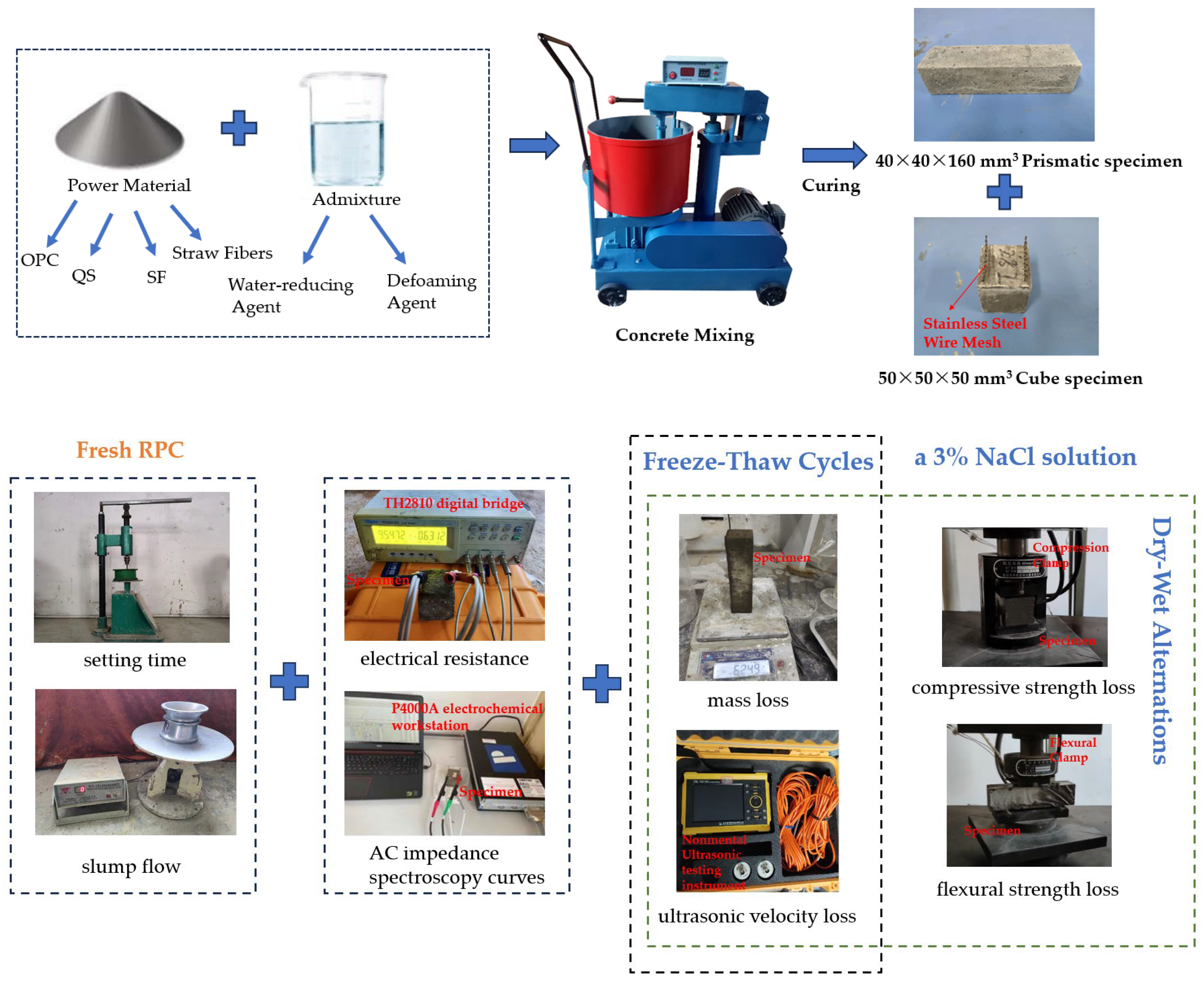
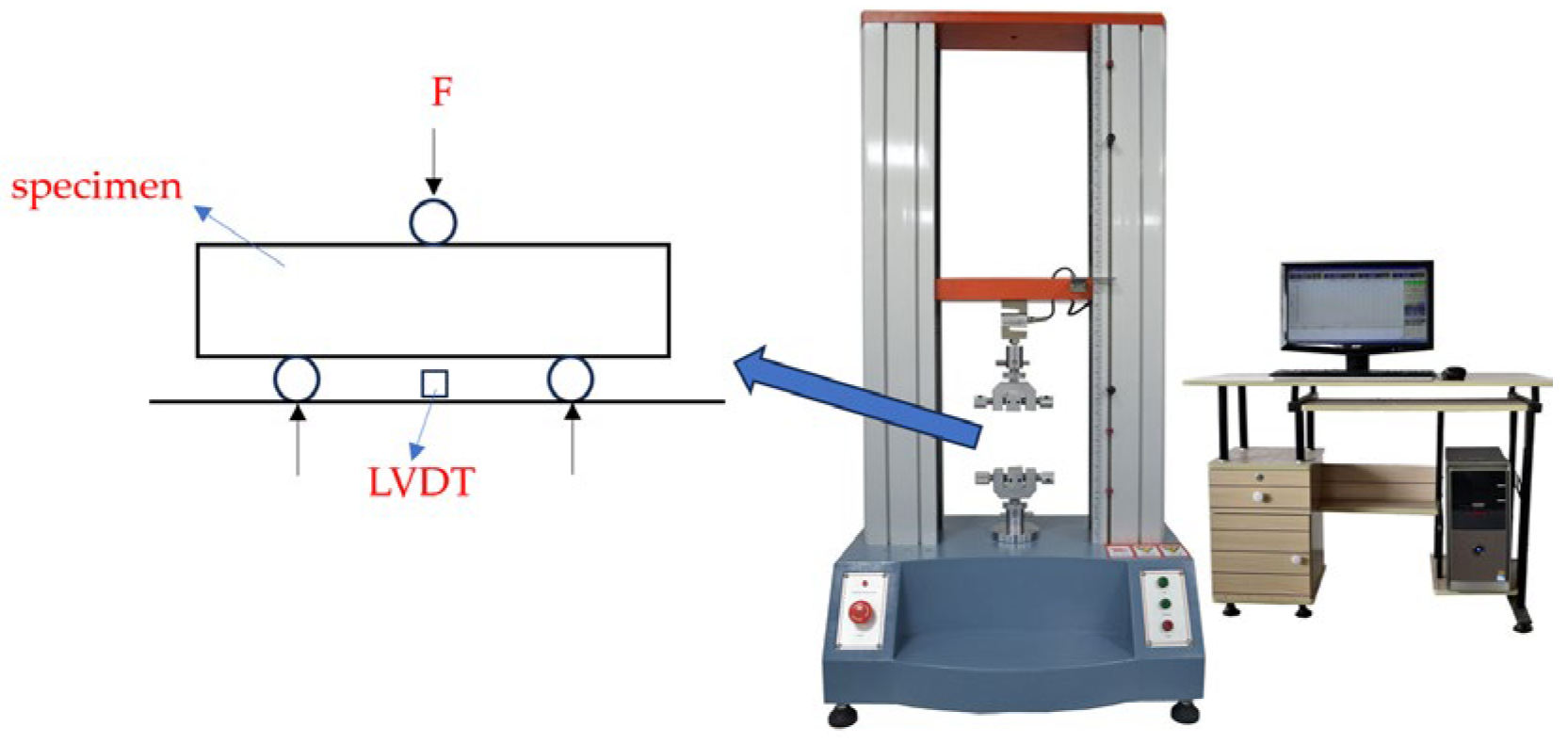
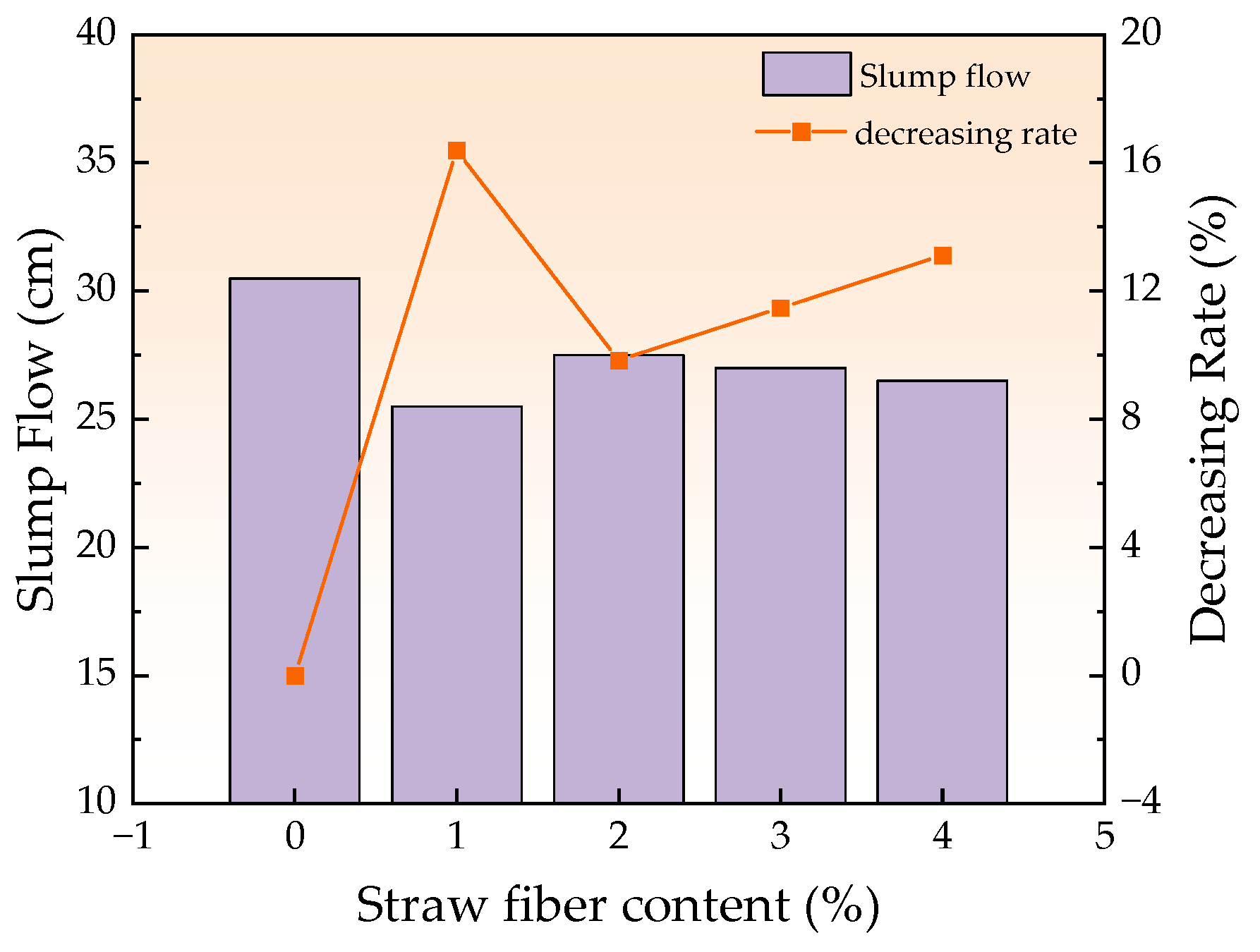
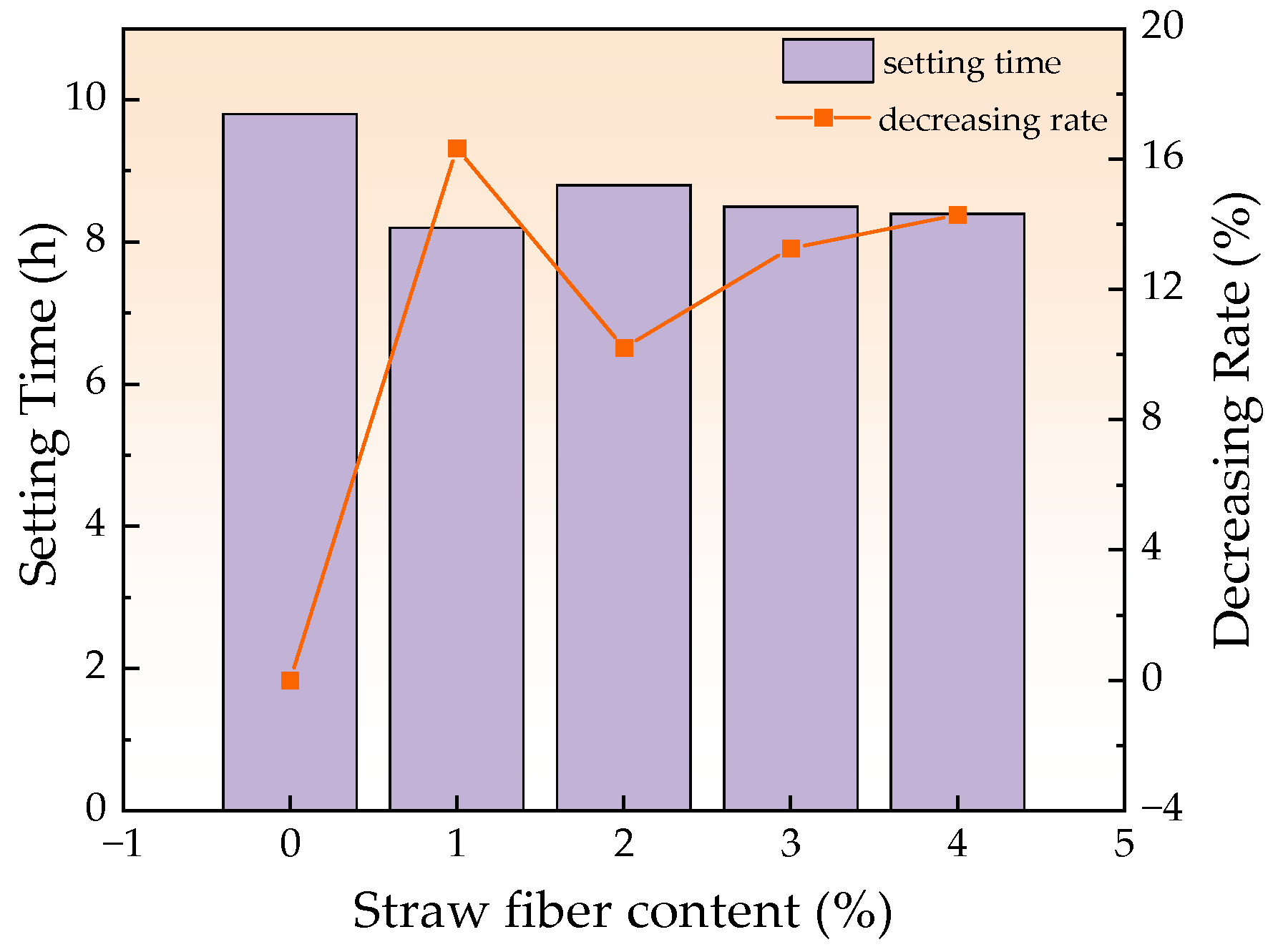

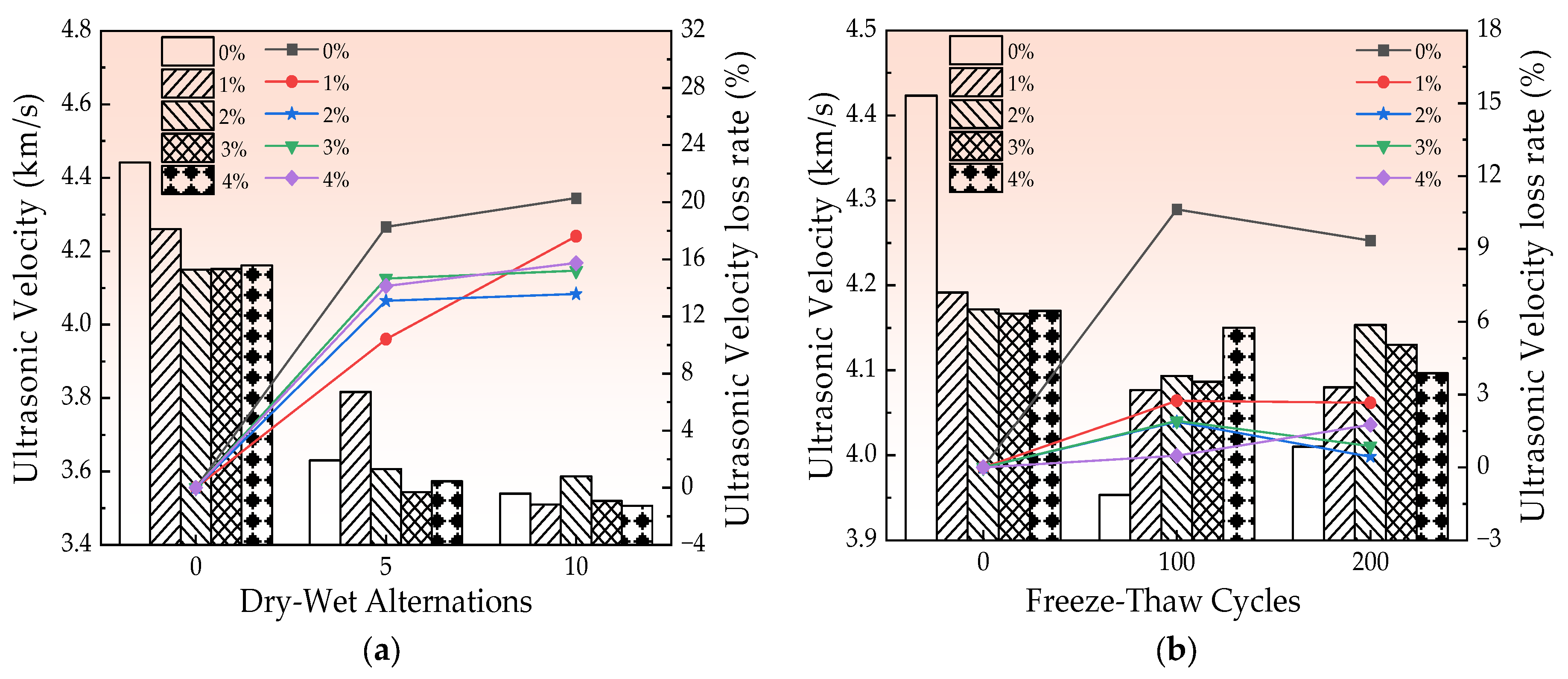

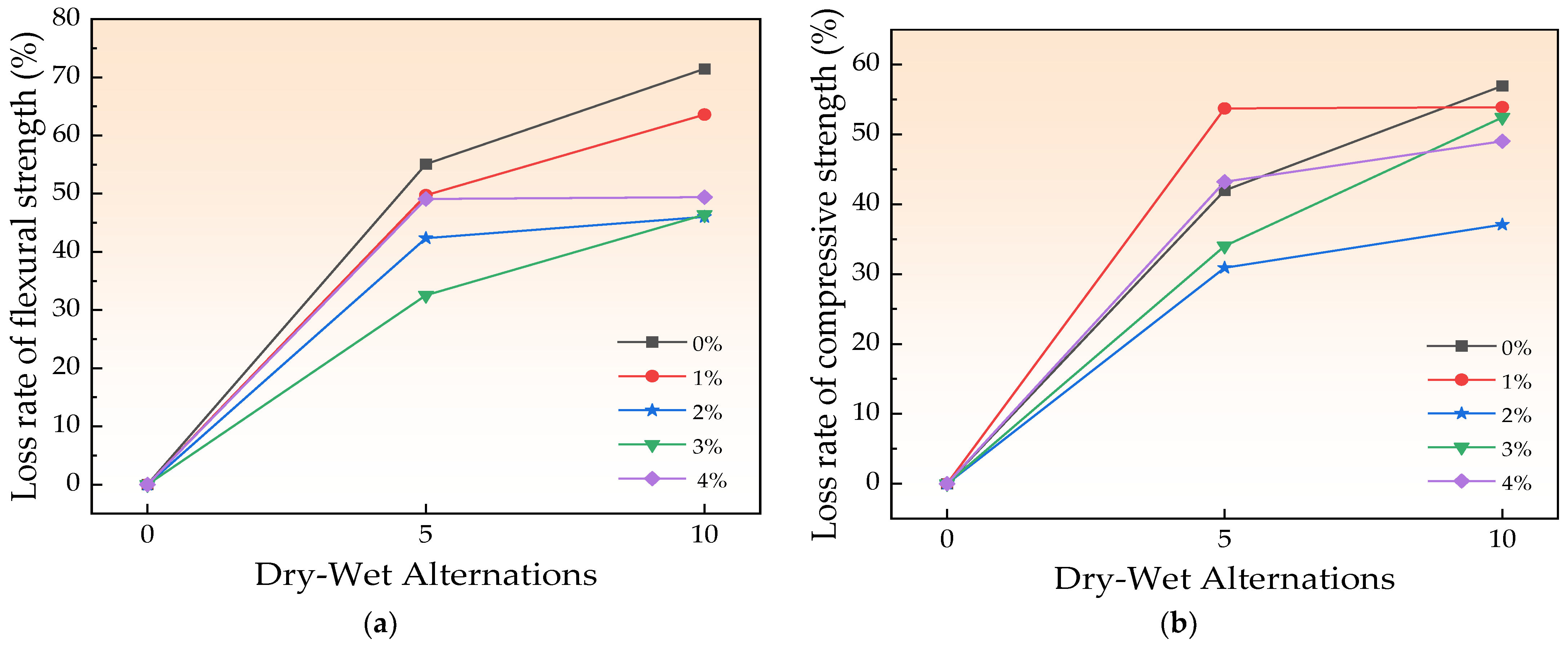


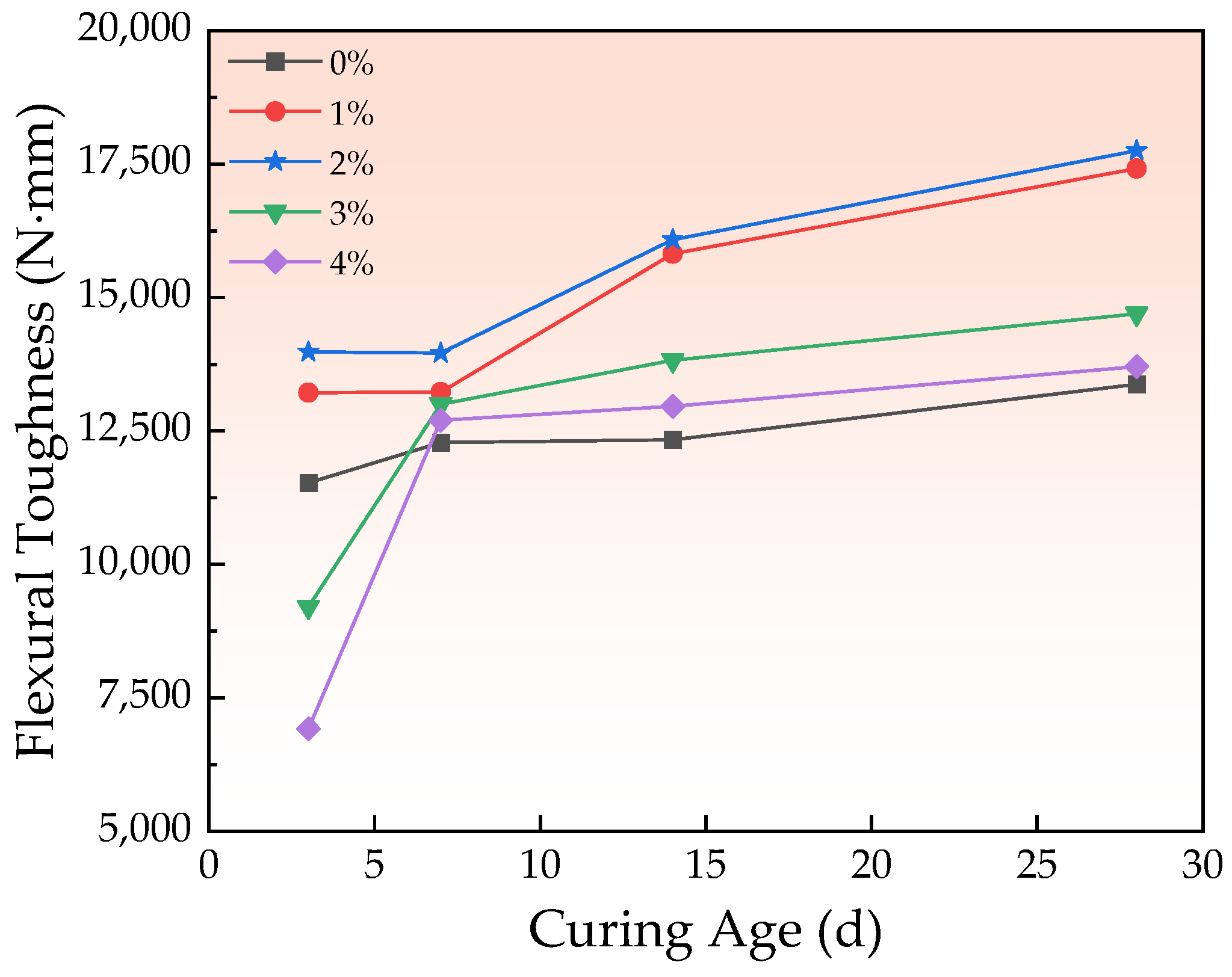
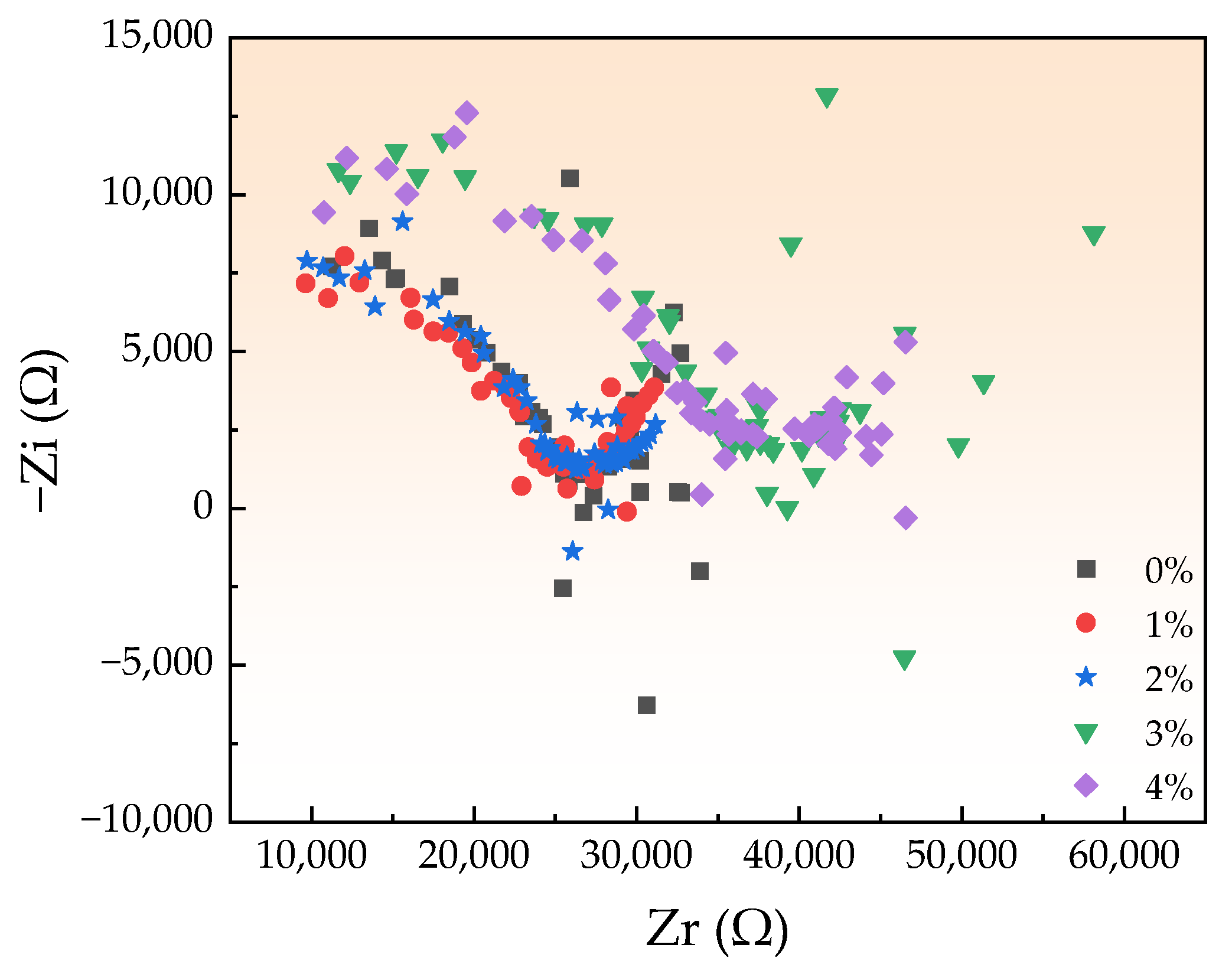
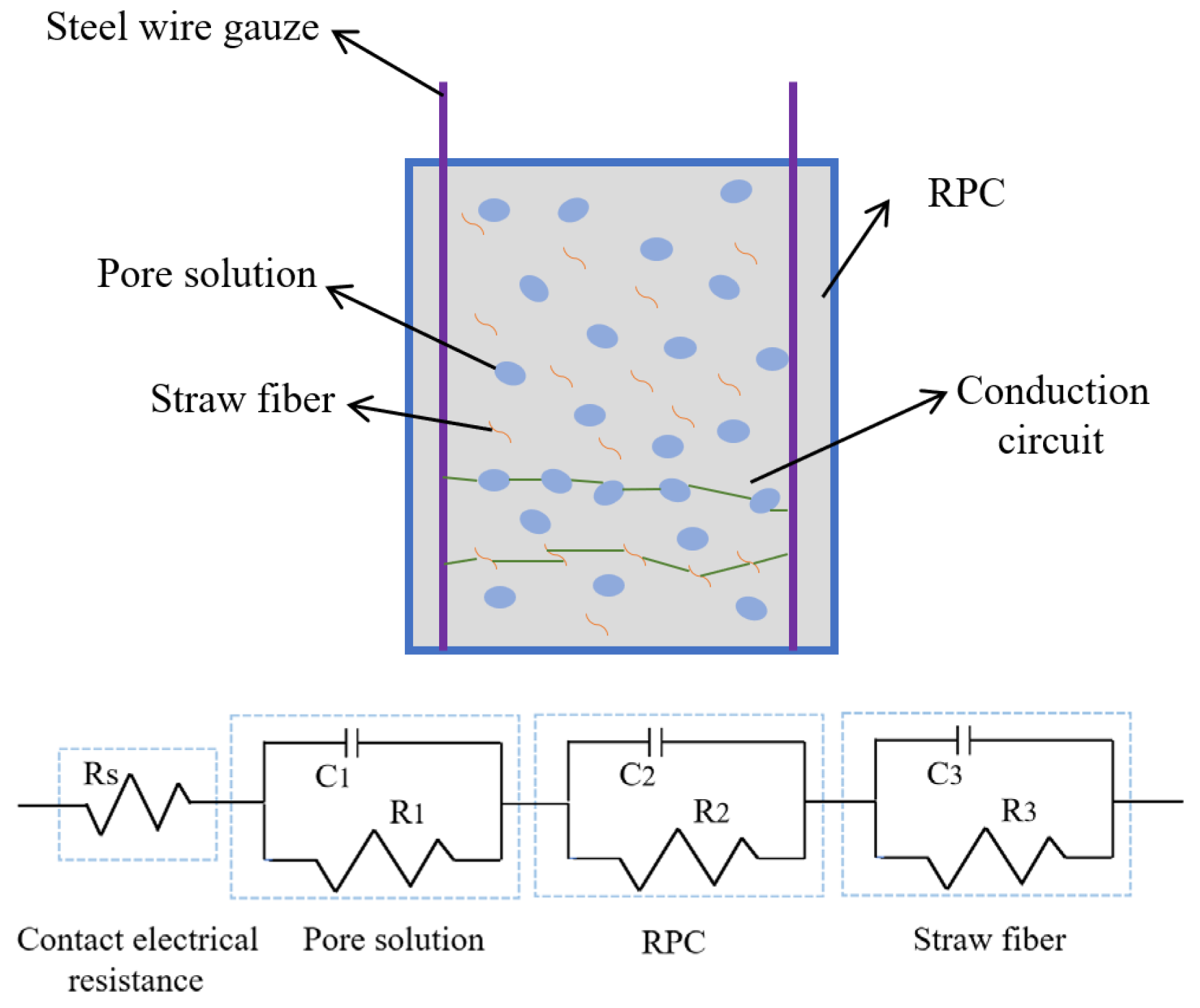
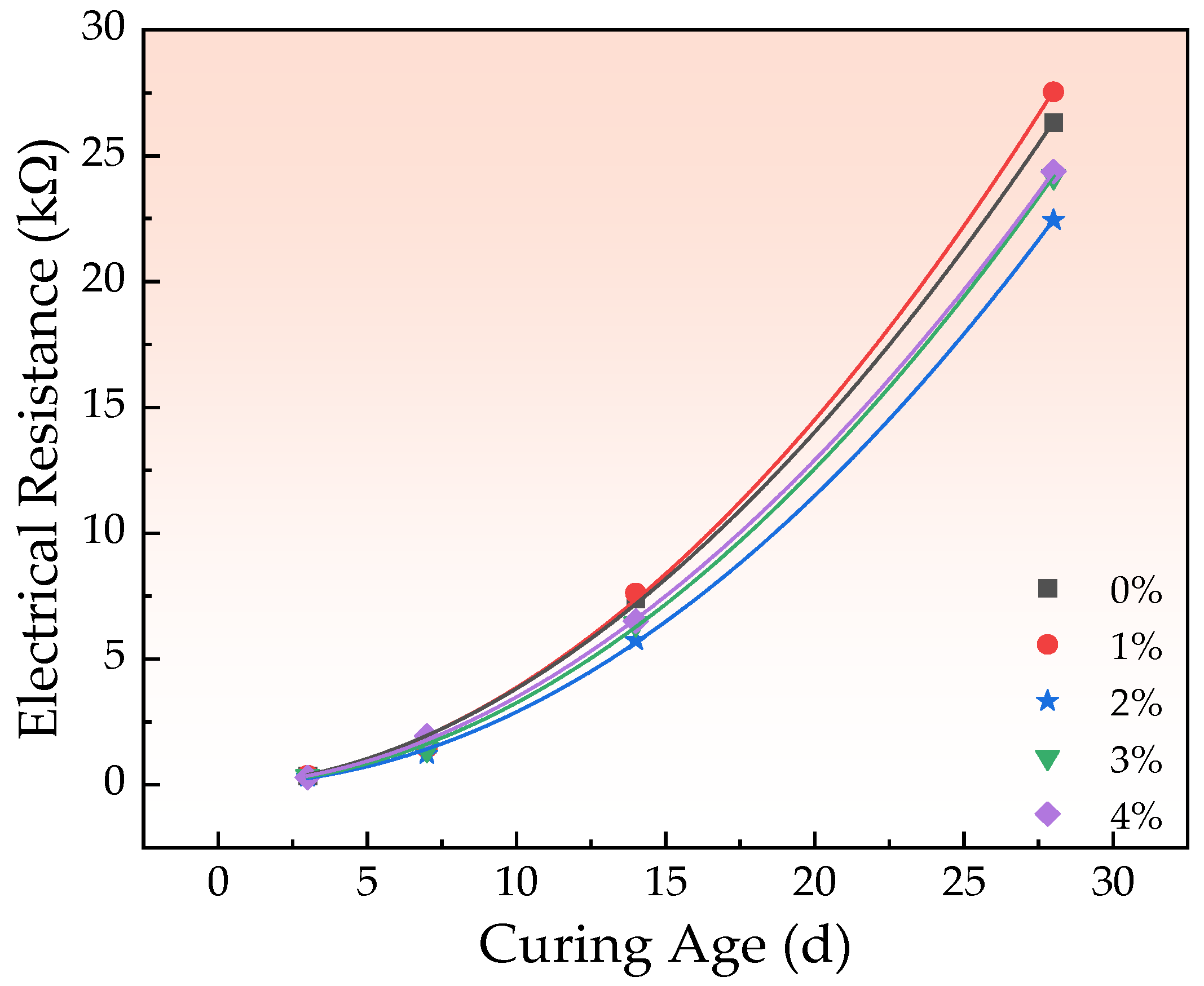
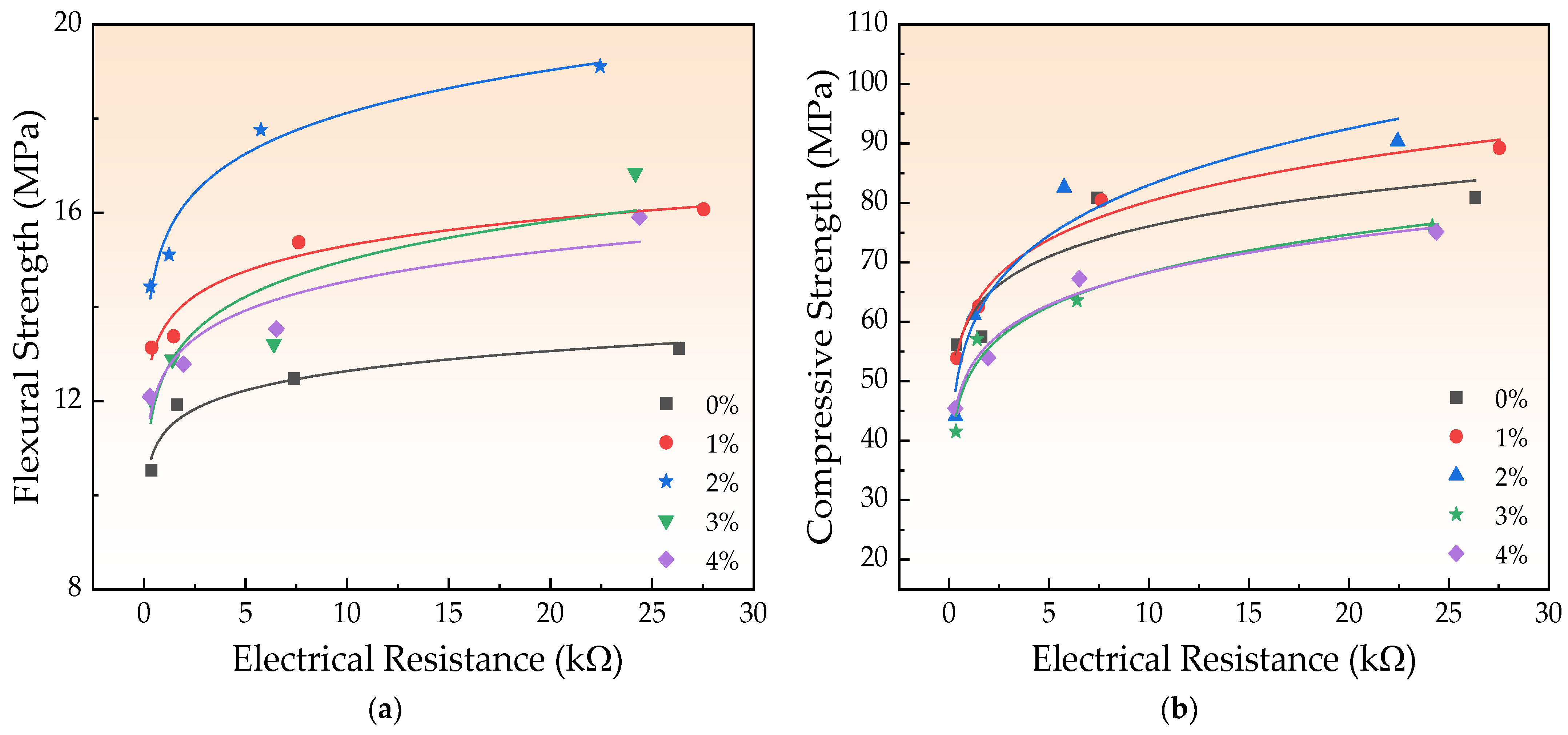
| Type | Chemical Composition/% | |||||||
|---|---|---|---|---|---|---|---|---|
| SiO2 | Al2O3 | Fe2O3 | MgO | CaO | SO3 | R2O | SiO2 | |
| OPC | 20.86 | 5.47 | 3.94 | 1.73 | 62.23 | 2.66 | 0.48 | 20.86 |
| QS | 34.06 | 14.74 | 0.83 | 9.73 | 35.93 | 0.23 | 3.51 | 34.06 |
| SF | 90 | 0.8 | 0.6 | 0.8 | 0.4 | 0 | 7.4 | 90 |
| Materials | Water | OPC | SF | QS | Water Reducer | Defoamer | Straw Fibers |
|---|---|---|---|---|---|---|---|
| 1 | 339.6 | 1018.9 | 339.6 | 679.2 | 26.4 | 1.32 | 0 |
| 2 | 339.6 | 1018.9 | 339.6 | 679.2 | 26.4 | 1.32 | 27 |
| 3 | 339.6 | 1018.9 | 339.6 | 679.2 | 26.4 | 1.32 | 54 |
| 4 | 339.6 | 1018.9 | 339.6 | 679.2 | 26.4 | 1.32 | 81 |
| 5 | 339.6 | 1018.9 | 339.6 | 679.2 | 26.4 | 1.32 | 108 |
| mass ratio | 14.12% | 42.36% | 14.12% | 28.24% | 1.09% | 0.05% |
| Fitting Function | R = a · tb | ||||
|---|---|---|---|---|---|
| 0% | 1% | 2% | 3% | 4% | |
| A | 0.05 | 0.05 | 0.03 | 0.04 | 0.05 |
| B | 1.87 | 1.91 | 1.99 | 1.95 | 1.88 |
| R2 | 0.99 | 0.99 | 0.99 | 0.99 | 0.99 |
| Fitting Function | fb = a · Rb | ||||
|---|---|---|---|---|---|
| 0% | 1% | 2% | 3% | 4% | |
| a | 11.32 | 13.56 | 15.39 | 12.59 | 12.58 |
| b | 0.047 | 0.05 | 0.07 | 0.08 | 0.06 |
| R2 | 0.94 | 0.94 | 0.95 | 0.81 | 0.88 |
| Fitting Function | fc = a · Rb | ||||
|---|---|---|---|---|---|
| 0% | 1% | 2% | 3% | 4% | |
| a | 60.44 | 60.85 | 58.01 | 50.92 | 51.89 |
| b | 0.10 | 0.12 | 0.15 | 0.12 | 0.12 |
| R2 | 0.83 | 0.98 | 0.94 | 0.96 | 0.98 |
Disclaimer/Publisher’s Note: The statements, opinions and data contained in all publications are solely those of the individual author(s) and contributor(s) and not of MDPI and/or the editor(s). MDPI and/or the editor(s) disclaim responsibility for any injury to people or property resulting from any ideas, methods, instructions or products referred to in the content. |
© 2024 by the authors. Licensee MDPI, Basel, Switzerland. This article is an open access article distributed under the terms and conditions of the Creative Commons Attribution (CC BY) license (https://creativecommons.org/licenses/by/4.0/).
Share and Cite
Wang, H.; Gong, K.; Cheng, B.; Peng, X.; Wang, H.; Xu, B. Effect of Chloride Salt Erosion on the Properties of Straw Fiber Reactive Powder Concrete. Coatings 2024, 14, 1069. https://doi.org/10.3390/coatings14081069
Wang H, Gong K, Cheng B, Peng X, Wang H, Xu B. Effect of Chloride Salt Erosion on the Properties of Straw Fiber Reactive Powder Concrete. Coatings. 2024; 14(8):1069. https://doi.org/10.3390/coatings14081069
Chicago/Turabian StyleWang, Hangyang, Kaiwei Gong, Bingling Cheng, Xi Peng, Hui Wang, and Bin Xu. 2024. "Effect of Chloride Salt Erosion on the Properties of Straw Fiber Reactive Powder Concrete" Coatings 14, no. 8: 1069. https://doi.org/10.3390/coatings14081069
APA StyleWang, H., Gong, K., Cheng, B., Peng, X., Wang, H., & Xu, B. (2024). Effect of Chloride Salt Erosion on the Properties of Straw Fiber Reactive Powder Concrete. Coatings, 14(8), 1069. https://doi.org/10.3390/coatings14081069







